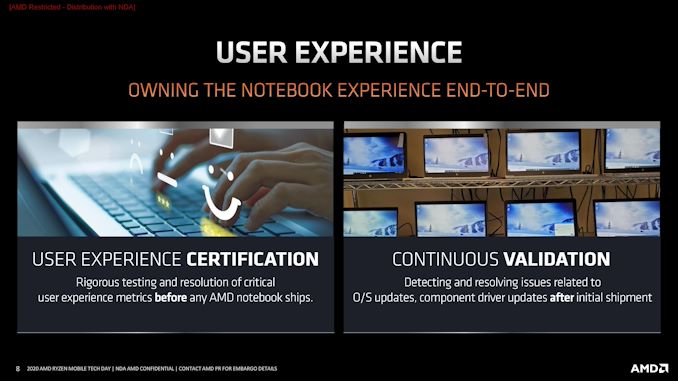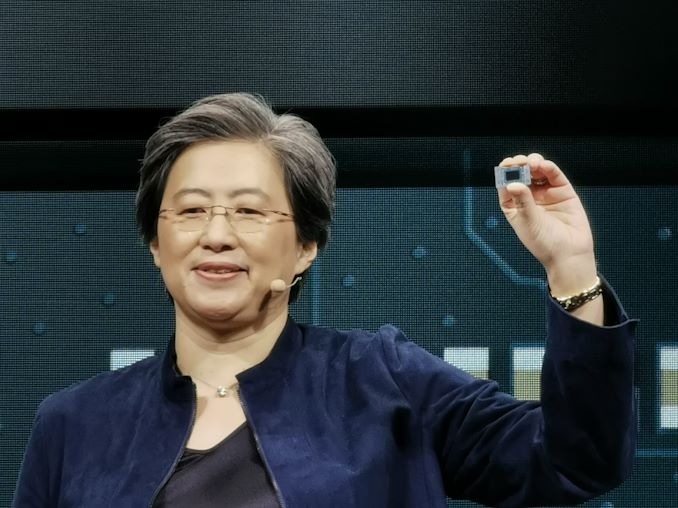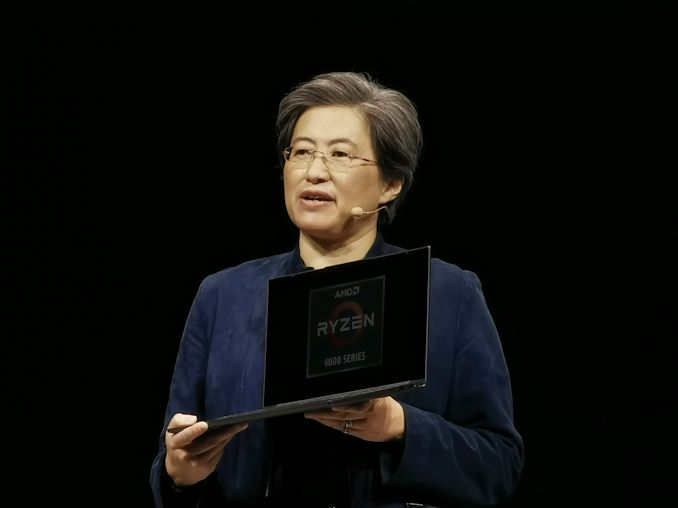AMD Details Renoir: The Ryzen Mobile 4000 Series 7nm APU Uncovered
by Dr. Ian Cutress on March 16, 2020 11:00 AM ESTThe Special HS Processors
As mentioned, at the top end of the new Ryzen Mobile 4000 list are the HS processors, offering almost exactly the same specification as the 45 W H-series processors, but at 35 W. AMD has marked these as special processors, not available to every OEM, because they fall under AMD’s new cooperative design and continuous validation programs.
In order to be able to use a HS processor, an OEM must work with AMD on the design. This is similar to what Intel does – ensure that the OEM partner gets the best from the hardware, and try and assist as to what design decisions the hardware was built for. Ultimately the product that comes out should be one that shows off the best of the hardware and gives the best user experience. On top of this, AMD has a list of ‘assured components’, validated to work against the new processors, and has created two continuous validation labs.
These labs, one in Austin and one in Shanghai, take the systems and pre-test all the new drivers and vendor software on them before they are released to the public. This is to ensure that the system is in no way compromised in performance, power, or thermals as a result of the update (to ensure that a company doesn’t completely mess with the power profile after it launches through a BIOS update or similar). AMD didn’t state how long its continuous validation program will run after the product is shipped, though I should think that at least 12-18 months should be plausible.
If the OEM does all this, and AMD agrees, then the product can use one of the HS processors.
(Note, the normal 45 W processors can be run in a 35 W mode, but just doing that doesn’t mean you can call it a HS. No doubt some third-tier OEM might try…)
The first HS-class system on the market will be the ASUS Zephyrus G14, and we learned in January that ASUS’s design has an exclusive for six months from launch. We’re expecting the G14 to hit the market in Q2, even with the current state of production, so we’ll see more HS models later in the year.
Conclusions
Ultimately today was the day that AMD was going to lift the embargo on Ryzen Mobile 4000 reviews, with the systems that AMD and its partners have provided. Due to the current ongoing issues around the world, those technical reviews of the systems will have to wait a few weeks while production is being ironed out. But for now we have a good grasp as to what AMD has pushing into the new processors coming out later this year.
Regular readers of AnandTech may remember back in 2016 I wrote a very long piece about AMD’s laptop strategy, where I tested five laptops from OEMs that were using AMD’s latest Carrizo APU at the time. The conclusions to that review were three fold: AMD was shooting itself in the foot by providing a platform that allowed its partners to be cheap; the OEM partners were being cheap by giving the hardware 13x7 screens, poor storage, poor trackpads and such because that’s all the customers seemed to want; and the customers were continually asking for cheaper systems, then getting frustrated with the poor user experience, ultimately blaming AMD rather than the OEM. It was a vicious cycle that required someone to break it.
Normally for these launches, a company will create a reference design for its partners to work with. AMD for years was creating these dull $500-$700 reference designs, which ultimately led to the paragraph above. We pled for generations for AMD to make a halo reference design, something ultraportable for $1500. For Renoir, given the reasonable performance uplift from the previous generation, the company worked with partners to create a range of high profile devices. I’ve covered a few of them in this article – the Lenovo Yoga Slim 7, the Dell G15 SE, and the ASUS Zephyrus G14 all attack different markets in very different ways, but all are examples of high-end products and design wins that AMD has needed in this market.
One of AMD’s big targets here is commercial. Despite the poor consumer performance of its older generations of laptops, the commercial laptop arm of AMD did reasonably well by comparison. AMD has announced its Ryzen Mobile 4000 Pro designs that afford admin control and sustainability over the lifetime of the product, and the key win here is that we’re seeing the processors in Lenovo’s Thinkpads, a key market.
The other big market is gaming. AMD can attack this on two fronts - the ultraportable market with the improved integrated graphics should get some good perfomrance, but also the more power hungry gaming market will get access to features like SmartShift to help balance the power between the APU and discrete GPU. AMD is also playing in the middle market here, with devices like the ASUS Zephyrus G14 with a HS processor and a Radeon RX5600M inside a 14-inch chassis, which AMD claims is the first 14-inch device with a H-class CPU and a discrete GPU inside. AMD's gaming team seem to be very happy with this design.
However, announcing systems is one thing. Deploying them is another. AMD has made a lot of claims about its Ryzen Mobile 4000 platform – performance, power consumption, and battery life. We’ve gone into detail into a lot of these, but we’re still missing one piece of the puzzle – the on-hand data. We’re hoping to get a system or two here in due course, and compare it against the competition.














95 Comments
View All Comments
Cooe - Friday, April 23, 2021 - link
Delusional idiot alert. Because creating super expensive HEDT pin-out sized bespoke sockets solely for low-mid end market desktop APU's definitely makes ANY kind of sense... -_-lisabmassey - Wednesday, March 25, 2020 - link
Make 6150 bucks every month... Start doing online computer-based work through our website. I have been working from home for 4 years now and I love it. I don't have a boss standing over my shoulder and I make my own hours. The tips below are very informative and anyone currently working from home or planning to in the future could use this website... WWW.iⅭash68.ⅭOⅯsuperflex - Thursday, May 21, 2020 - link
Do you have to swallow for $6150RamIt - Monday, March 16, 2020 - link
Looking forward for a test unit. Battery life and mild gaming may make me shift to AMD.EliteRetard - Monday, March 16, 2020 - link
I think a 48-4900 HS without a GPU would be the perfect laptop for most people.I've been wishing for something like this for a very long time.
High core count and TDP for real work, with enough IGP for casual gaming. Still lower power than a 45w chip, especially since they're always paired with at least a 25w GPU (even though most don't need it).
U series for those who care about battery above all else, HS + IGP for the vast majority, and H + DGPU for gamers and mobile workstations.
Please make it so!
deksman2 - Monday, March 16, 2020 - link
Actually, I'd prefer they give the APU full 45W TDP 'breathing room', otherwise it will 'choke' on the 35W TDP constraints.Most laptop OEM's don't really pay too much attention in designing adequate cooling systems for their designs, which can lead to thermal throttling, overheating and performance losses.
I'd rather they work with the 'maximum allowed TDP' for the chip (say 45W) design a cooling system that's more than enough to handle it and work from there.
I'd prefer seeing 4900H with a decent dGPU such as RX 5700M and proper cooling design to produce limited noise under full load and that both CPU/IGP and dGPU can reach/sustain their maximum advertised performance indefinitely (or for as long as one needs them).
I need productivity on the go, and I have no time for cooling shenanigans from OEM's.
EliteRetard - Monday, March 16, 2020 - link
35w gives tons of "breathing room", it's over twice the TDP of U series parts.It's also half the power of a 45w CPU plus low end 25w DGPU.
I fully expect it'll maintain a good 3+GHz under full load (vs 2GHz for U series).
For cooling, OEMs can just slap on the cooler from their 45w designs.
The vast majority of people don't need a DGPU, but they are currently forced to buy one if they want any performance CPU. That costs them more money, increases weight, and reduces battery life (two fold, less space for battery and higher draw).
You obviously want a gaming laptop, and that's not at all what I'm discussing.
80% of the market would be incredibly well served with a 35w HS APU.
Far better than the crappy U series they've been forced into.
For the 10% who want battery life over anything, they can get a 15w U series.
For the 10% who want max gaming they can get a 45w H series.
I've been begging for a logical laptop for so long... I seriously can't understand why OEMs have refused to even consider it. In what other industry do manufactures refuse to service the needs of 80% to cater only for the odd 20%? "Oh you want something practical? HA screw you!"
Imagine if you could only buy a 2 seat scooter for $15+k, or a massive 4 door 8ft bed truck for $100+k. And there are literally no other options, new or used...there has been only these two choices being sold by every car maker in the entire world. If you want to do anything more than a scooter can handle, you are literally forced to buy a massive overkill option no matter how impractical.
That's literally how the laptop market has been for almost a decade.
wolfesteinabhi - Tuesday, March 17, 2020 - link
i totally see where you are going with this ...but for vast majority .. people dont care about CPU's and performance ... all they ask is a cheap laptop with good battery life....they dont even compare or ask for model numbers for CPUs .... they jsut see its as core i3 or core i5 ... or Ryzen 3/5 .. thats all they "perceive" as performance..... and lastly they want it dirt cheap. (also they expect to have a dGPU to always out perform iGPU ....even if dGPU is pants like MX150)erple2 - Wednesday, March 18, 2020 - link
Frankly, the 4800 is much more capable than what most people need in a laptop. I've seen people effectively develop applications on an Atom based Chromebook with great success, and based on what I see other people that aren't enthusiasts doing, even the bottom tier 4600H is more than they need. It's exceedingly rare for any normal user to need more than even 4 cores to do their normal workload of opening tabs, checking email, talking on videochat.Namisecond - Thursday, March 26, 2020 - link
I agree, for general computing tasks, 4 cores or 4 fully powered threads is good enough for most people. In a laptop, for a lot of people, the important factors are: size/weight, screen quality, battery life, design aesthetics, not necessarily in that order.I used to buy thin-and-light gaming laptops for my own perceived needs...but recently, I've found that I'm carrying the atom-powered thin and light, because the screen is good enough, the size and weight is good, and it has all-day battery life.